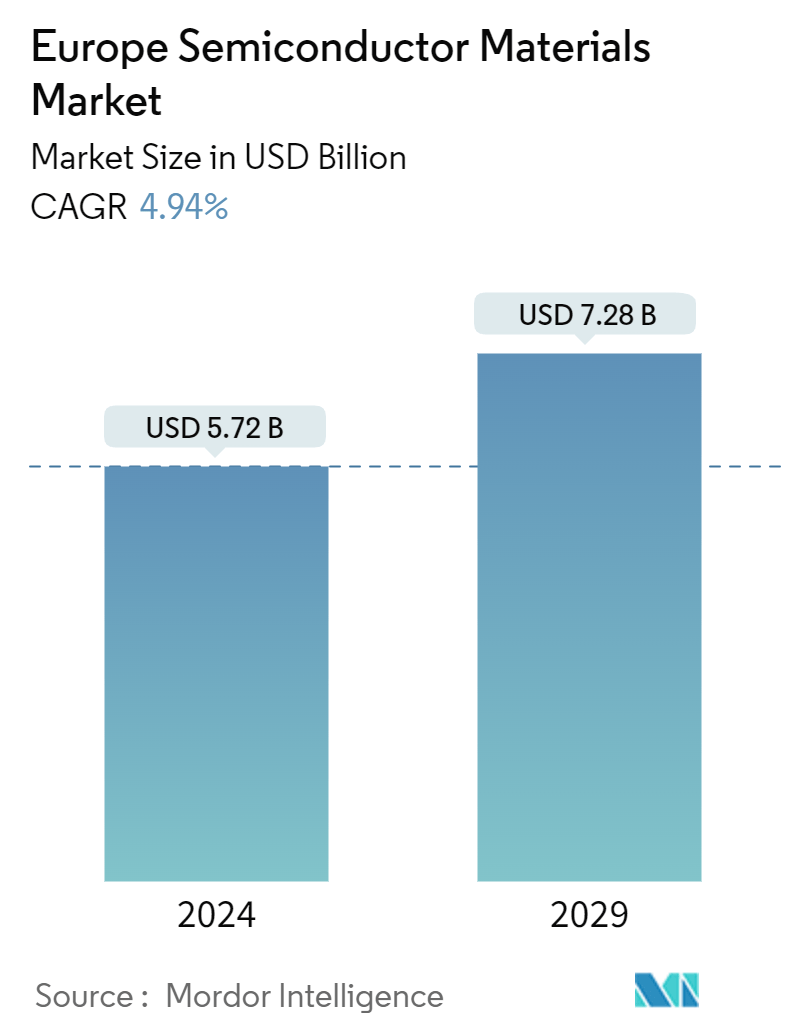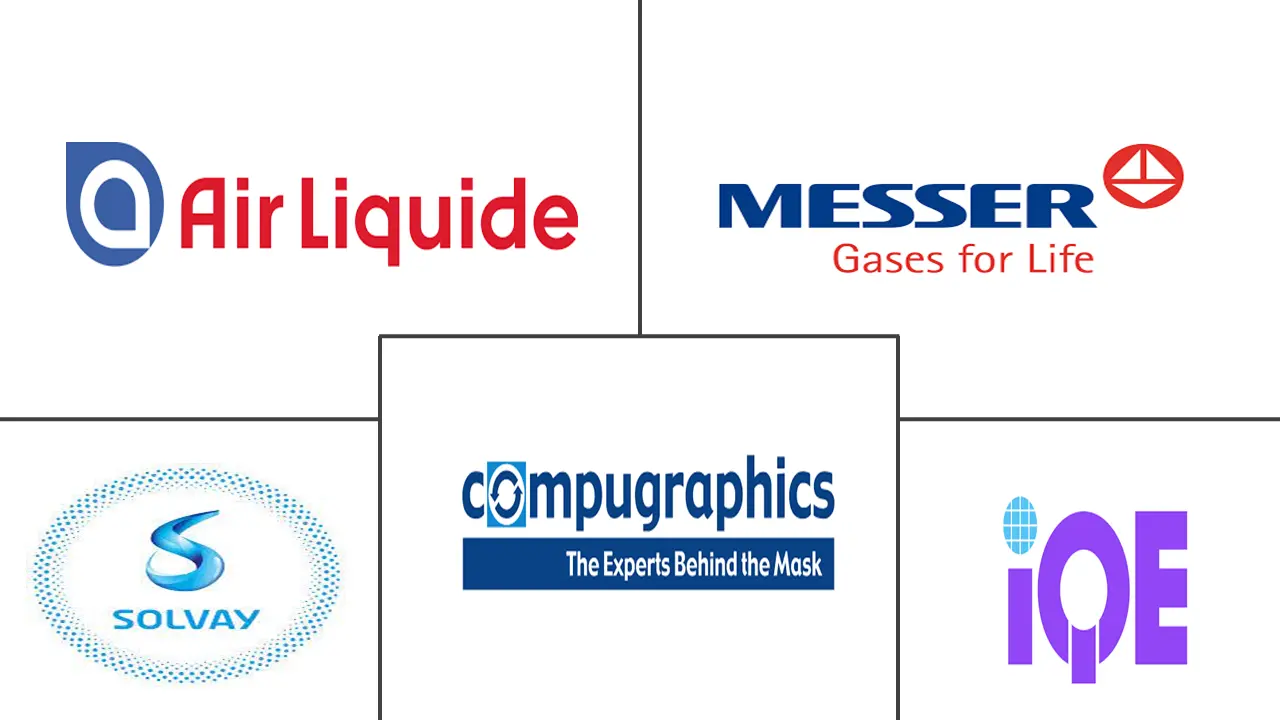Market Size of Europe Semiconductor Materials Industry

| Study Period | 2019 - 2029 |
| Base Year For Estimation | 2023 |
| Market Size (2024) | USD 5.72 Billion |
| Market Size (2029) | USD 7.28 Billion |
| CAGR (2024 - 2029) | 4.94 % |
| Market Concentration | Low |
Major Players*Disclaimer: Major Players sorted in no particular order |
Need a report that reflects how COVID-19 has impacted this market and its growth?
Europe Semiconductor Materials Market Analysis
The Europe Semiconductor Materials Market size is estimated at USD 5.72 billion in 2024, and is expected to reach USD 7.28 billion by 2029, growing at a CAGR of 4.94% during the forecast period (2024-2029).
Semiconductor materials represent one of the significant innovations in the electronics industry. By employing materials such as silicon (Si), germanium (Ge), and gallium arsenide (GaAs), electronics manufacturers have been able to replace traditional thermal devices that made electronic items heavy and non-portable.
- Silicon is the most popular semiconductor element available in the current market scenario. However, the increasing demand for ever-smaller, faster-integrated circuits has pushed the efficiency of the material to its limits, with many industry experts fearing silicon will soon reach the limits of Moore's Law. In the meantime, various research initiatives are being undertaken to develop new materials, driving innovation in the studied market.
- Moreover, with the miniaturization trend gaining momentum in the semiconductor industry, the demand for semiconductor materials is also expected to grow as manufacturing advanced node ICs, heterogeneous integration, and 3D memory architectures require more processing steps, driving higher wafer fabrication and packaging materials consumption as a result.
- Higher energy efficiency and resulting lower losses in all electronic operations is a general trend in the industry. As such, the demand for energy-efficient components is expected to grow strongly, especially in energy-intensive applications, from electric vehicle drives to charging stations and power supplies.
- The semiconductor industry is considered one of the most complex industries. This is because more than several processing steps and various products are involved in their manufacturing and the harsh environment it faces, e.g., the volatile electronic market and the unpredictable demand.
- The outbreak of the COVID-19 pandemic worldwide, including in Europe, significantly disrupted the supply chain and production of the market studied. Many end-user industries of the market were also affected by the pandemic, which, in turn, had a negative impact on the market.
Europe Semiconductor Materials Industry Segmentation
A semiconductor is a silicon-based material that conducts electricity better than an insulator like glass but not a pure conductor like copper or aluminum. Materials used to pattern the wafer are considered fabrication materials within the scope of the study. In contrast, materials used to protect or connect the die are called packing materials. Semiconductor fabrication is a set of operations that involves depositing a sequence of layers onto a substrate, most often silicon, to create a device structure. Various thin film layers are deposited and removed in this process. Photolithography is used to regulate the portions of the thin film that are to be applied or removed. Cleaning and inspection stages are usually performed after each deposition and removal operation.
The European semiconductor materials market is segmented by application (fabrication (process chemicals, photomasks, electronic gases, photoresists ancillaries, sputtering targets, silicon, and other fabrication applications), packaging (substrates, lead frames, ceramic packages, bonding wire, encapsulation resins (liquid), die-attach materials, and other packaging applications)), end-user industry (consumer electronics, telecommunication, manufacturing, automotive, energy and utility, and other end-user industries). The market sizes and forecasts are provided in terms of value (USD) for all the above segments.
| By Application | |||||||||
| |||||||||
|
| By End-user Industry | |
| Consumer Electronics | |
| Telecommunication | |
| Manufacturing | |
| Automotive | |
| Energy and Utility | |
| Other End-User Industries |
Europe Semiconductor Materials Market Size Summary
The European semiconductor materials market is poised for significant growth, driven by the increasing demand for advanced electronic devices and the ongoing trend of miniaturization in the industry. Semiconductor materials, such as silicon, germanium, and gallium arsenide, are crucial in replacing traditional thermal devices, making electronics lighter and more portable. The market is experiencing a shift towards more flexible substrates, with innovations like flexible processors and the integration of III-V materials with silicon germanium technology. These advancements are essential for developing smaller, faster, and more efficient integrated circuits, addressing the challenges posed by Moore's Law. The demand for energy-efficient components is also on the rise, particularly in energy-intensive applications like electric vehicles and power supplies, further fueling market expansion.
The market landscape is moderately concentrated, with several major players and high barriers to entry due to the technology-intensive nature of the industry. Strategic collaborations and investments, such as those by IQE PLC and STMicroelectronics, are enhancing the development and production of compound semiconductor products and silicon carbide wafers, respectively. These efforts are aligned with the growing need for high-performance materials in various applications, from wireless communications to power electronics. The market's growth is also supported by initiatives to increase production capacity and recycling capabilities, ensuring a steady supply of materials to meet the rising demand from automotive and industrial sectors.
Europe Semiconductor Materials Market Size - Table of Contents
-
1. MARKET INSIGHTS
-
1.1 Market Overview
-
1.2 Industry Attractiveness - Porter's Five Forces Analysis
-
1.2.1 Bargaining Power of Suppliers
-
1.2.2 Bargaining Power of Consumers
-
1.2.3 Threat of New Entrants
-
1.2.4 Threat of Substitute Products
-
1.2.5 Intensity of Competitive Rivalry
-
-
1.3 Industry Value Chain/Supply Chain Analysis
-
1.4 Impact of COVID-19 on the Market
-
-
2. MARKET SEGMENTATION
-
2.1 By Application
-
2.1.1 Fabrication
-
2.1.1.1 Process Chemicals
-
2.1.1.2 Photomasks
-
2.1.1.3 Electronic Gases
-
2.1.1.4 Photoresists Ancillaries
-
2.1.1.5 Sputtering Targets
-
2.1.1.6 Silicon
-
2.1.1.7 Other Fabrication Applications
-
-
2.1.2 Packaging
-
2.1.2.1 Substrates
-
2.1.2.2 Lead Frames
-
2.1.2.3 Ceramic Packages
-
2.1.2.4 Bonding Wire
-
2.1.2.5 Encapsulation Resins (Liquid)
-
2.1.2.6 Die Attach Materials
-
2.1.2.7 Other Packaging Applications
-
-
-
2.2 By End-user Industry
-
2.2.1 Consumer Electronics
-
2.2.2 Telecommunication
-
2.2.3 Manufacturing
-
2.2.4 Automotive
-
2.2.5 Energy and Utility
-
2.2.6 Other End-User Industries
-
-
Europe Semiconductor Materials Market Size FAQs
How big is the Europe Semiconductor Materials Market?
The Europe Semiconductor Materials Market size is expected to reach USD 5.72 billion in 2024 and grow at a CAGR of 4.94% to reach USD 7.28 billion by 2029.
What is the current Europe Semiconductor Materials Market size?
In 2024, the Europe Semiconductor Materials Market size is expected to reach USD 5.72 billion.


